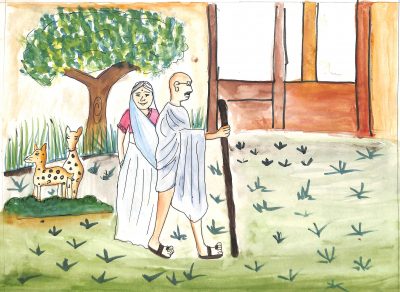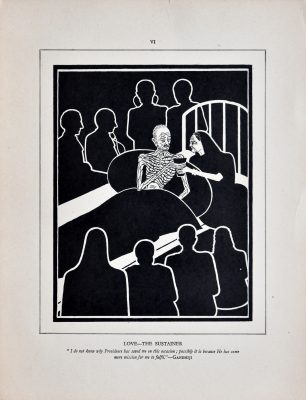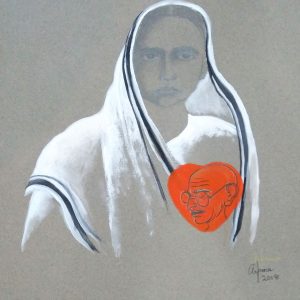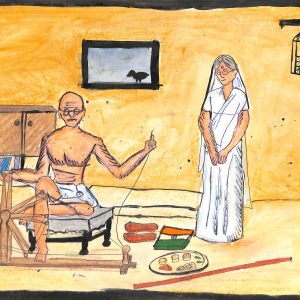
Bapu and Ba
In the flurry of activities in and around India on the occasion of the 150th birth anniversary of the Mahatma, it is frequently forgotten that the year 2019–20 marks his wife’s sesquicentenary as well. The Gandhi Smarak Nidhi and Mani Bhavan Gandhi Sangrahalaya in Mumbai are an exception in this regard, marking the year in various ways, including issuing a new biography of Kasturba Gandhi on the occasion of her death anniversary on 22 February 2020. For the purposes of this project, it is crucial to underscore that Bapu was betrothed to Ba when they were both children themselves, seven years of age, with their marriage taking place a few years later when they were 13-year-olds. In his autobiography (published in English in two volumes between 1927 and 1929), Gandhi was unusually candid for a man of his times about his sexual relationship with the young Kastur. Some analysts have even suggested that his experiences in this regard shaped his (largely negative) views on children’s sexuality, a topic about which he worried a lot and wrote candidly as well. In My Early Life (1932), the much-abridged version of his autobiography for young readers whose publication he personally supervised, these experiences are not mentioned in much detail, although in a chapter titled “The Double Shame,” Gandhi recounts, “I have never been able to efface or forget the shame of having deserted for the satisfaction of carnal desire a dying father’s bedside… It took me long to free myself from the shackles of lust, and I had to pass through many ordeals before I could overcome it.” The young Mohan and Kastur were both only 16 at this point, and soon after, they lost their firstborn. “Nothing else could be expected,” Gandhi concludes.
A shadowy figure in much of his early correspondence and frequently invoked as “my wife” in his autobiography, Kasturba (or “Ba” as she was invariably referred to) was undoubtedly a force to be reckoned with. In My Early Life, Gandhi tells his young readers,
My wife, with her matchless powers of endurance, has always got the better of me. I am no longer a blind, infatuated husband, no more presuming to be her teacher. We are tried friends, the one no longer regarding the other as an object of lust. She has been a faithful nurse throughout my illnesses, serving without any thought of receiving even so much as thanks, and in utter self-effacement she has followed me in all the important steps I have taken.
Some of the toughest moments of friction between husband and wife were around children. Kasturba was clearly agitated and outspoken over the consequences to the lives of their four boys on account of Gandhi’s numerous “experiments,” including and especially over their schooling but also their livelihoods. In 1920, when Gandhi formally adopted a girl he called Lakshmi, the young daughter of Dudabhai Dafda and Daniben, the antyaj (“untouchable”) couple who took up residence in his ashram in Ahmedabad in 1915, Kasturba initially appears not to have been happy (in the Mahatma’s telling of the event). However, oral histories collected by her grandson Arun have it that she soon embraced little Lakshmi as “a child of god,” helped raise her at the ashram, and was instrumental in her marriage arrangements in 1933. On Ba’s death in 1944, a sacred bead (rudraksha) necklace she wore was given to young Lakshmi as keepsake, presumably following her wishes.
In fact, for the many children who grew up in Gandhi’s communal settlements and ashrams, “Ba” was clearly a proxy mother. One of them, Vanamala Parikh, went on to write an early affectionate biography in Gujarati, Amaran Ba (Our Ba), that was published in 1945 soon after Kasturba’s death and for which Gandhi wrote a revealing foreword (with a passing comment, “Poor girl, she would write about Kasturba but how could she forget me, with whom she romped around and played as a child?”). Gandhi’s 14-year-old grandniece Manu, who was summoned in March 1943 to take care of her ageing aunt while both Bapu and Ba were in prison, has left a detailed diary of her day-to-day interactions with “Motiba,” whom she came to consider her second mother. Amidst candid confessions of some of the trials and tribulations of taking care of an ailing older woman are also moments of pure joy, as evident from the diary entry for 21 April 1943,
After 3 o’clock I slept by her side. Ba caressed me with deep love. It has been four years since the death of my mother. Four years ago, I would sleep by my mother’s side and she would caress me affectionately and put me to sleep. I recall that experience and felt that after four years Ba made me sleep by her side, just as my mother used to. And she touched me with her loving hand, it gave me limitless joy. And the memories of my mother, which had faded, came alive. It brought tears to my eyes. Today, it was if my mother had caressed me, such was the joy.
Kasturba’s grandson Arun, who last saw her in 1939 when he was a five-year-old himself, went on to write an informed biography of his grandmother, remarking on the challenges of doing so about a woman “who wrote very little herself.” This is of course in striking contrast to his grandfather who wrote copiously, and whose every musing it has been attempted to save and record for posterity.
Grandnephew Dhiren, who grew up in Gandhi’s ashram and was the first artist to hail from the family, published a volume of prints in 1944, the year of Kasturba’s passing. Although meant to be “a glimpse into Gandhiji’s soul,” the volume is “dedicated to Motiba (Revered Kasturba), as a humble token of my elder brother’s and my gratitude to her for her constant motherly care of us.” A print titled Love–The Sustainer features Ba reviving a skeletal Bapu with nourishment after the punishing fast (Fig. 5). That elder brother Navin in fact produced a life-size portrait of her in 1938 which Gandhi mentions in passing in his correspondence.
From Between the Lines: Drawings by K.M. Adimoolam between 1962 and 1996. Chennai: Value Arts Foundation, 1997
From Between the Lines: Drawings by K.M. Adimoolam between 1962 and 1996. Chennai: Value Arts Foundation, 1997
Among other professional and gallery artists, Kasturba flickers in and out of their work, more frequently than not in Gandhi’s company. Mumbai-based artist Atul Dodiya (b. 1959), perhaps the most diligent of visual chroniclers of Gandhi’s life, has produced a few works including most recently of the very young Mohan and Kastur, in his signature shutter series (Fig. 3). In his centenary series completed in 1969, Tamil artist K.M. Adimoolam (1938–2008) included two portraits, Gandhi with Kasturba (In South Africa) and Traditional Young Couple, drawing on grainy photographs of Bapu and Ba (Fig. 6; Fig. 7).
Other notable works include
With Kasturba (2014), painted by Gandhian Haku Shah (1934–2019) (Fig. 8), and a recent work revealingly titled Shadow (2019) by Kolkata-based Debanjan Roy (b. 1975), which makes us pause and ask who is whose shadow (Fig. 9). Neither of these works is based on a historical photograph. In contrast, a much earlier work by Vadodara-based Surendran Nair (b. 1956), repurposes a photograph taken by Gandhi’s grandnephew Kanu. Nair’s painting shows Kasturba engaged in what at first sight seems like the rather conventional task of a wife serving her husband’s needs. On the other hand, the subversive title bestowed upon the piece by the artist, Family Values, may well be a reminder of the female labor of care that sustained the Mahatma’s disobedient practices and habits (Fig. 10).Although there is no doubt that Kasturba matters to most artists because she was Gandhi’s wife, there are occasionally those who have taken her seriously in her own right as an individual. She was amongst the first women of her caste and class background to go to prison in colonial South Africa in 1913 fighting for her rights and those of her fellow Indians (and indeed, this is an act that Gandhi did not fail to praise for its courage in My Early Life to his young readers). An early portrait of her has been credited to Bengali artist Mukul Dey (1895–1989) who visited the Gandhis in their ashram on the banks of the Sabarmati in 1928. Years later after her passing in 1944 when he presented Gandhi with this 1928 portrait, the Mahatma reportedly held the work “tenderly close to his eyes, as if he was talking to her for a while.” Sometime after her passing, Ahmedabad-based Shanti Shah produced a conventional portrait of her in oil on canvas, most likely based on a photograph (Fig.11). In recent years, among the most moving portraits of Kasturba have been produced by New Delhi-based Arpana Caur (b. 1954) who shows her as a devoted but determined woman, a person in her own right (Fig. 12; Fig. 13).
Image courtesy Vijay Kumar Aggarwal, Swaraj Art Archive, Noida
Image courtesy the artist
Image courtesy Mani Bhavan Gandhi Sangrahalaya
and Gandhi Smarak Nidhi, Mumbai
Mumbai, 2011
Image courtesy Mani Bhavan Gandhi Sangrahalaya
and Gandhi Smarak Nidhi, Mumbai
The mostly female trustees and convenors of the painting competitions of Mani Bhavan are also dedicated to sustaining the memory of Kasturba. It is perhaps not surprising that over the years, the children of Mumbai have been invited to paint her on numerous occasions, usually around the topic of Gandhi in his ashram on the Sabarmati or in Sevagram (digital album, 69, 86–95) (Fig. 4). The child artist responds by drawing and painting her in Gandhi’s company in all manner of guises ranging from an ageing woman (Fig. 14) to a young shy bride, as in seventh-grader Ronak’s imagination (Fig. 15). I have not seen a single child’s portrait focused just on her. On the other hand, consider a painting titled Gandhiji in My Imagination (Fig. 1): young Atharva can only imagine Bapu by seeing Ba by his side!
Image courtesy Mani Bhavan Gandhi Sangrahalaya and Gandhi Smarak Nidhi, Mumbai
Image courtesy Mani Bhavan Gandhi Sangrahalaya and Gandhi Smarak Nidhi, Mumbai
Image courtesy Mani Bhavan Gandhi Sangrahalaya and Gandhi Smarak Nidhi, Mumbai
Kasturba is Bapu’s companion in spinning (Fig. 16), and even is painted marching with him to make salt (although the historical record shows otherwise) in fifth-grader Sahil’s painting (Fig. 17). She is presented as well sharing Gandhi’s values of truth, independence, non-violence, honesty, and freedom by young Dishita (Fig. 18). In short, the child artist restores Kasturba to her rightful place—by Gandhi’s side—in the thriving visual culture that has emerged around the Mahatma.
Collected Works of Mahatma Gandhi 79: 132-33.
M.K. Gandhi, My Early Life (1869–1914), Arranged and Edited by Mahadev
Desai. Bombay: Oxford
University Press, 1932.
Mukul Dey, Portraits of Mahatma Gandhi. Bombay: Orient Longman, 1948; Arun Gandhi, Kasturba: A Life. New Delhi: Penguin, 2000; and Tridip Suhrud, ed. and trans., The Diary of Manu Gandhi, 1943-1944. New Delhi: Oxford University Press, 2019.

















